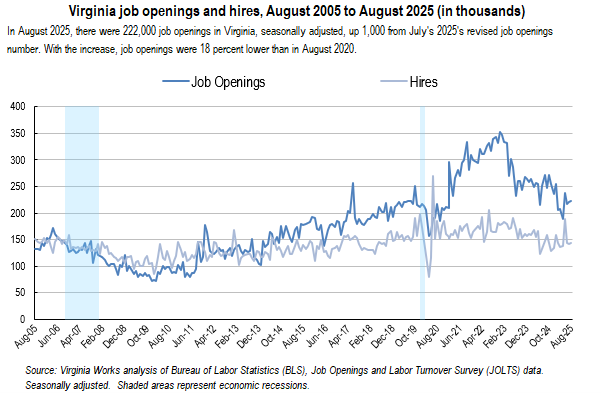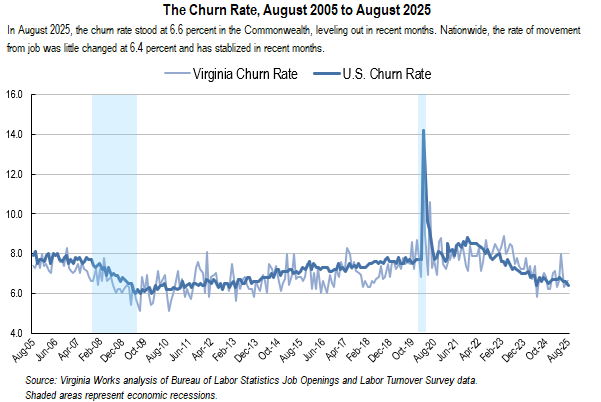December 8, 2025
RICHMOND Virginia Works (the Virginia Department of Workforce Development and Advancement) announced today that the U.S. Bureau of Labor Statistics (BLS) August 2025 Job Openings and Labor Turnover Survey (JOLTS) reports steady levels of job separations, buoyed by a rise in job quitting.
On the last business day in August, there were 222,000 job openings in Virginia, seasonally adjusted, an increase of 1,000 from July s upwardly revised figure of 221,000. Job openings were 18 percent lower than August 2024 s figure. Nationwide, the number and rate of job openings was unchanged at 7.2 million, in August. The number of U.S. job openings significantly decreased in construction (-115,000) and in federal government (-61,000). The Virginia job openings rate was little changed at 4.9 percent. Nationwide, the job openings rate stood at 4.3 percent.
The number of hires in Virginia was 144,000 in August, up by 2,000 from July s revised figure and little changed over the year. JOLTS defines hires as all additions to the payroll during the month. In August, the number of U.S. hires was little changed at 5.1 million.
In Virginia, the 3.4 percent hires rate was little changed over the month. The U.S. rate of hires nationwide was little changed at 3.2 percent.

The
Virginia hires-per-job-opening (HPJO) ratio was two hires for every
three job openings, which was slightly lower than the nationwide rate of seven
hires for every ten job openings. This measure shows the rate of hiring
compared to open jobs and is a proxy for time to fill positions. In August
2025, there were 0.7 unemployed per job opening in the Commonwealth,
compared to one unemployed per job opening nationwide.
Total job separations in Virginia was unchanged at 137,000. Nationwide, the number of total separations in August was little changed at 5.1 million. The Virginia total separations rate stood at 3.2 percent. Nationwide, the total separations rate remained little changed at 3.2 percent. The total number of separations decreased significantly in accommodation and food services (-113,000) and in arts, entertainment, and recreation (-48,000). Total separations increased in state and local government, excluding education (+27,000).
An estimated 91,000 workers quit jobs ( quits ) from Virginia employers in August, up by 12,000 over the month. Nationwide in August, the number of quits was little changed at 3.1 million. The number of quits decreased in accommodation and food services (-140,000) and in arts, entertainment, and recreation (-22,000). Quits increased in construction (+56,000). The quits rate in the Commonwealth was unchanged at 2.1 percent. Over the month, the U.S. quits rate was little changed at 1.9 percent. The August churn rate (the sum of the

hires
and total separations rates) in Virginia increased by 0.1 percentage points
from July s revised figure and was driven by an increase
in job quits. It equaled the U.S. churn rate, which was little changed over the
month.
The number of layoffs and discharges in Virginia was 40,000 in August, a decrease of 11,000 from July s revised estimate. In August, the number of U.S. layoffs and discharges was unchanged at 1.7 million. Layoffs and discharges decreased in wholesale trade (-36,000) and in federal government (-4,000). The Virginia layoffs and discharges rate fell to 0.9 percent. In August, the U.S. rate of layoffs and discharges was unchanged at 1.1 percent.
On the last business day of August, JOLTS data indicated that labor market conditions improved, with decreases in layoffs and increases in job quits.
BLS s JOLTS data provides information on all the components that make up the net change in the number of jobs over a month, including job openings, hires, layoffs, voluntary quits, and other job separations (including retirements and worker deaths). Together, these components attempt to reveal the overall change in payroll employment. JOLTS data is seasonally adjusted and describes conditions on the last business day of the month. The current month s data is preliminary and the previous month s data has been revised.
|
Job Openings Job openings include all positions that are open on the last business day of the reference month. A job is open only if it meets the following three conditions: (1) A specific position exists and there is work available for that position; the position can be full time or part time, and it can be permanent, short term, or seasonal; (2) the job could start within 30 days, whether or not the employer can find a suitable candidate during that time; and (3) the employer is actively recruiting workers from outside the establishment to fill the position. Excluded are positions open only to internal transfers, promotions or demotions, or recalls from layoffs. Hires Hires include all additions to the payroll during the entire reference month, including newly hired and rehired employees; full-time and part-time employees; permanent, short-term, and seasonal employees; employees who were recalled to a job at the location following a layoff (formal suspension from pay status) lasting more than 7 days; on-call or intermittent employees who returned to work after having been formally separated; workers who were hired and separated during the month; and transfers from other locations. Excluded are transfers or promotions within the reporting location, employees returning from a strike, and employees of temporary help agencies, employee leasing companies, outside contractors, or consultants. Separations Separations include all separations from the payroll during the entire reference month and are reported by type of separation: quits, layoffs and discharges, and other separations. Quits include employees who left voluntarily, except for retirements or transfers to other locations. Layoffs and discharges include involuntary separations initiated by the employer, including layoffs with no intent to rehire; layoffs (formal suspensions from pay status) lasting or expected to last more than 7 days; discharges resulting from mergers, downsizing, or closings; firings or other discharges for cause; terminations of permanent or short-term employees; and terminations of seasonal employees (whether or not they are expected to return the next season). Other separations include retirements, transfers to other locations, separations due to employee disability, and deaths. Excluded are transfers within the same location, employees on strike, and employees of temporary help agencies, employee leasing companies, outside contractors, or consultants. *Excerpted from U.S. Bureau of Labor Statistics, Handbook of Methods, "Job Openings and Labor Turnover Survey: Concepts," https://www.bls.gov/opub/hom/jlt/concepts.htm. |
Virginia Works plans to release the October 2025 analysis of the BLS Job Openings and Labor Turnover Survey for Virginia on Friday, December 19, 2025. The data for all states and the U.S. will be available on the BLS website JOLTS page, at https://www.bls.gov/jlt/. BLS is scheduled to release the August JOLTS data for states on Wednesday, December 17, 2025.
![]()
 Technical note:
Effective with the release of May 2025 data, the Job Openings and Labor
Turnover Survey (JOLTS) state estimates have been benchmarked and revised to
include the annual benchmark revisions to JOLTS national estimates, the Current
Employment Statistics (CES) employment estimates, and the Quarterly Census of
Employment and Wages (QCEW) data. Seasonally adjusted and not seasonally
adjusted data from January 2019 forward are subject to revision. The Bureau of
Labor Statistics (BLS) Job Openings and Labor Turnover Survey (JOLTS) produces
monthly data on U.S. and regional job openings, hires, quits, layoffs and
discharges, and other separations from a sample of approximately 21,000
establishments. For more information on the program s concepts
and methodology, see Job Openings and Labor Turnover Survey: Handbook of Methods (Washington,
DC: U.S. Bureau of Labor Statistics, July 13, 2020), https://www.bls.gov/opub/hom/jlt/home.htm. For more information on BLS state JOLTS
estimates, see https://www.bls.gov/jlt/jlt_statedata.htm. Definitions of JOLTS
terms*
Technical note:
Effective with the release of May 2025 data, the Job Openings and Labor
Turnover Survey (JOLTS) state estimates have been benchmarked and revised to
include the annual benchmark revisions to JOLTS national estimates, the Current
Employment Statistics (CES) employment estimates, and the Quarterly Census of
Employment and Wages (QCEW) data. Seasonally adjusted and not seasonally
adjusted data from January 2019 forward are subject to revision. The Bureau of
Labor Statistics (BLS) Job Openings and Labor Turnover Survey (JOLTS) produces
monthly data on U.S. and regional job openings, hires, quits, layoffs and
discharges, and other separations from a sample of approximately 21,000
establishments. For more information on the program s concepts
and methodology, see Job Openings and Labor Turnover Survey: Handbook of Methods (Washington,
DC: U.S. Bureau of Labor Statistics, July 13, 2020), https://www.bls.gov/opub/hom/jlt/home.htm. For more information on BLS state JOLTS
estimates, see https://www.bls.gov/jlt/jlt_statedata.htm. Definitions of JOLTS
terms*
 PDF of Press Release
PDF of Press Release 